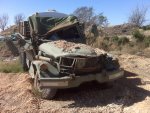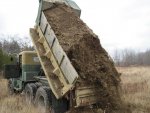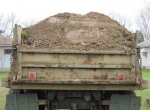I'm going to pick on the deuce, because it's what I'm familiar with, but the others are principally the same.
Weight ratings are a lot different than they were back when they were given their classifications. Back when the M35 was new, it's civilian weight rating would have been (or would have been able to have been) 40,000 pounds. That's what the components were good for. (12,000 pound front axle, and two fourteen thousand pound rears). The front tires obviously would have been chosen differently.
Bear in mind, this was a time when a driver was someone who drove, and not just a passenger in the right front seat. A driver knew how to not overdrive his brakes. (Which were rated for the axle loads). A driver knew what his point of no return was when he crested a hill. A truck that didn't have the horsepower to keep up to speed was not "weak", it's just how it was. Add more gears until it can get the job done. A truck creeping down a hill was not a traffic hazard, it was just what trucks did. The deuce was good for every penny of that weight.
Fast forward to today.... Most drivers have no or limited experience (regardless of knowledge of the subject) in keeping track of their brakes. Today's brakes have us spoiled to where we don't think twice about following the speed limit down a winding mountainside. They are overkill to the point that you almost have to actively try to make them overheat. Or up it for that matter. Most little economy cars have as much horsepower as the Deuce.
Road speed limits (and expectations, and even minimum speed limits in some cases) are way beyond what was out there when the deuce came around. Traffic is thick enough and pushy enough that driving in what was the accustomed style then is not practical now. Driving below the speed limit DOES make you a traffic hazard, simply because "the other guy" does not know how to react to that, and even if they did, they don't have the patience to do so.
It is simply not practical to say that what a weight rating was then would be comperable in the same way now as it was then.
If you're in an environment where there is no other traffic, where speed is not an issue, and where you're free to drive the truck to it's ability, and most importantly NOT to anybody else's expectations, it can and will still move a mountain. Way over the data tag ratings, and way over the component ratings. Remember those components were designed back when stuff was "built" as much as it was "engineered".
The trouble is when you throw modern speeds, modern traffic, and modern pushiness into the mix. Ever try to leave a ten or twelve second following distance to the car in front of you? You can have every intention in the world of driving safely, but is anyone else going to allow you to keep that distance? Not today. Probably not tomorrow. When you're the only vehicle on the road, except for one car who wants to pull in from a side street, how much time will THEY allow you before they pull out in front? Probably just enough for a modern truck with modern tires to stop.
The bottom line is, the structural capacity of the truck the truck (which is easily attainable) is from a different era.
40,000 pounds. Limited to 36 with the most common tire selection. Way less with some options. DOT is good with those numbers even today.
In today's world, short of having your own acreage with a private road network, you will never safely realize the structural capacity. Of course, if you do have such a situation, you'll quickly realize that tires can hold many many times their "rating" with no damage if you never move fast enough to heat them up. (The more the weight, the slower that is). Same goes for structural members. They're rated for what they can carry at a given speed, and with a given durability. You can go WAY over what they're rated for.
If the truck isn't telling you what is safe, and you need a number to be sure, then you need to stick to the data tags and maybe less. If you are comfortable with how the truck is performing, comfortable with the traffic around you, and are lucky enough to live in a relaxed part of the country where pushy drivers don't pass slow trucks, then fear not about what the truck can handle. You'll chicken out before it does.
More directly to the original post, and the conservative ratings for the military's purposes, these trucks are rated for on-road and off-road. Someone (Perhaps David Doyle?) summed this up very well. The conditions in question were off-road, which constituted anything that a soldier could make the truck go through. On-road simply meant somebody drove a buldozer through the woods. Our modern system of roadways was not at all what they envisioned.










